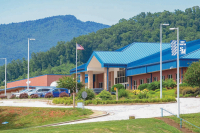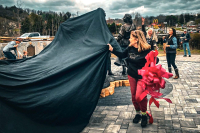Pedaling my America: Jackson County native A.J. Rowell prepares for 10,000-mile summer cycling ride from Arctic Alaska to Cullowhee
By Michael Beadle
Before you ask the most obvious question – why? – remember, it’s not a race or a sudden urge to drop out of society so he doesn’t have to pay his bills.
Like the bumper sticker reminds us, “All who wander are not lost.”
When A.J. Rowell sets out this week on a 10,000-mile journey to bike from northern Alaska through three Canadian provinces, 22 national parks, and 13 states, over mountains, along the Gulf Coast and back up to his hometown of Cullowhee, he will not only raise $25,000 for charities. He’ll meet a lot of friends along the way and savor the kind of rare experiences that many of us might take a lifetime just to imagine.
As a Western Carolina University grad armed with a degree in accounting and corporate finance, Rowell could have pursued a lucrative career with an accounting firm in Charlotte, but instead his passion led him to the open road where he finds more stories in a day than most folks in an office cubicle could tell in a year.
So why ride a bike clear across North America?
Related Items
Like Tour de France champ Lance Armstrong might respond, “It’s not about the bike.”
It’s about finding your passion. Whatever you’re passionate about, go out there and do it, Rowell says.
No doubt, A.J. Rowell is the kind of guy who lives for adventure — even if that means staring down 100-degree highways in Iowa or pedaling through blustery Arctic winds or fighting off swarms of vicious mosquitoes. Sure there are days when the rain is pouring, the tires go flat, and it’s a long way to the next town.
“You do ask yourself, ‘What am I doing?’” he says.
But then he imagines what people in true poverty have to put up with day in and day out. Then it doesn’t seem so bad. And besides, he jokes, a bad day of biking is still better than a good day at the office.
Rowell, an Eagle Scout, has carefully done his homework for this trip. He’s spent countless hours looking over maps, reading up on the places he’ll be visiting, and poring over annual reports on the most well-respected charities with a proven track record of financial responsibility — in other words, the bulk of the money you send goes to the worthy cause. Rowell came up with five major charities for people to contribute to as he rides across America — Heifer International (to combat world hunger), the Conservation Fund (to protect the environment), Teach for America (to promote public education), the United Methodist Committee for Relief (for humanitarian aid worldwide), and the United Fund of Jackson County (a hometown, grassroots effort which helps more than 30 non-profit organizations in his native county). There’s information about each charity and how to donate on his Web site — http://whyiride.org.
“I have been fortunate in my life to be loved by an incredible family, and although I might complain sometimes, I am soon reminded that I have never done without,” Rowell states on his Web site. “After graduating from Western Carolina in 2005, I began to witness the large gaps in our society. Why, in the wealthiest nation on Earth, do some people have a high standard of living when others can’t even afford health care or food for their families?”
With all the work he’s put into researching and planning this multi-charity fundraiser, Rowell is already looking at setting up his own foundation and may one day pedal around the globe raising money for worthy causes.
“My mission is to help people along the way,” he says.
Rowell also likes to tout bicycles over cars as a cleaner form of transportation. For him, the thought of riding along on an interstate at 70 miles an hour just can’t compare to cruising on a 360-degree two-wheeled convertible which gets 1,000 miles per gallon across small-town USA.
The ‘Bear’ Essentials
No doubt, taking on a journey like this means sorting through a great many details. It’s taken a full year just to plot it all out. He’s sold his Prius (to his mom) and cut off all other bills except for health insurance and the cell phone. When he flies out to Alaska this week, it will be a one-way ticket.
Rowell estimates a daily budget of about $30 a day. Sometimes you can get by on $10 a day, he adds, and with all the calories he’ll be expending, he’ll take full advantage of those all-you-can-eat buffets.
He’ll mostly stick to the back roads, where travelers can soak up the scenic beauty and true character of a nation. As he burns some 8,000 calories a day and logs an average of 75 miles in each stage, you might imagine him chugging down hyper-protein shakes and devouring dozens of energy bars made of super-vitamins, but he’s just as happy to hit the grocery store for a pack of doughnuts or visit the local tavern for a home-cooked meal.
When he’s loaded up with bags and wearing “regular” clothes instead of the skin-tight cyclist gear, drivers tend to treat him with more courtesy.
“People are so nice to you,” he says.
As he comes to a new town, he’ll ride up to a gas station or ask the first person he sees to point him toward the best place to eat. Just to be sure, he’ll get a second opinion. Usually both will recommend the same place.
Most often people ask him where he’s headed and why he’s riding. He’ll stop and chat with veterans, retirees, teachers, students, people from all walks of life. He’ll often get invited to dinner.
Alaska may well prove the most dangerous and time-consuming part of his trip. There won’t be many trees in the north country of Alaska to protect his food stash from brown bears, so he’ll carry along a three-gallon plastic canister and two cans of bear spray. The Alaskan North Slope is also home to one of the world’s largest migratory routes for birds, so he’ll have plenty of company in the land of the midnight sun. Alaska also has some pretty rough mosquitoes, Rowell adds, so he’ll have to wear netting around his face and body while he rides. Normal bug spray won’t work.
“Literally, they’ll eat you alive,” he says.
He’ll camp just about every night, sleeping in parks, churches, even schools and people’s homes.
The first 500 miles or so will be almost all gravel with lots of dust. Add to that the heavy-duty trucks which shred tires that litter the road and chew up road bike tires like tiger claws on silk. So Rowell will take along several extra tire tubes. And, of course, a helmet and reflective vest for safety, plus an emergency first aid kit, repair tools, lots of duct tape, a heavy jacket for the cold winds, rain gear, two sets of riding clothes, gloves, SPF 50 sunscreen. Water and water treatment tablets, an international stove and cooking pot, dried food and energy bars, tent gear, a pad and a sleeping bag, and plenty of other essentials like a global positioning system, his passport and maps.
The total weight of the bike will be between 78 and 98 pounds including water. Depending on the wear-and-tear of the roads, Rowell plans on going through about a dozen tires, replacing them about every 800 miles.
This kind of preparation and dedication comes from someone who’s put in the miles and earned the respect of local cyclists. Dave Molin, the former owner of Motion Makers Bicycle Shop in Sylva, has seen Rowell develop from an avid high school mountain biker to a serious touring cyclist.
“He’s a good rider in a lot of different respects,” Molin said.
With his experience biking across country and overseas in places like New Zealand, Rowell has the stamina and endurance to hang with the big dogs, according to Molin. When Rowell was just starting out on his touring trips, Molin would offer the young rider advice both practical and technical. On those long trips, you’ve got to know everything from repairing break pads and cables to having the right kinds of accessories.
“You try to prepare for anything and you can’t,” said Molin, who has been on his share of grueling bike rides, though none as maddening as 10,000 miles.
A lot of people have no idea why people like A.J. take on such challenging trips, Molin said. Your friends think you’re crazy but to cyclists, it’s a very self-satisfying endeavor.
Motion Makers has helped Rowell sell calendars as a fundraiser for his trip, and Molin is happy to offer discounts for a steady customer who has become a great cycling ambassador.
“He likes to take it to the extreme level, and he does it quite well,” Molin said of Rowell.
This summer, Motion Makers will be keeping up with Rowell’s email newsletter during his tour across the country.
Where the Wind Blows
Just to be sure about safety, Rowell has also been contacting the Bureau of Land Management to find out what the conditions will be like in places like Alaska.
“Whatever you think is going to happen, the opposite can happen,” he says.
As a daily ritual, he likes to wet his finger and stick it up in the air to figure out the wind’s direction.
“The wind can be your best friend, or it can be your worst enemy on a trip like this,” he says.
Once in Montana, a steady tailwind took him 120 miles in about four hours. But when it’s in your face, all you can do is grin and bear it.
His 2005 Trek 520 steel-frame bike has 27 speeds to ease him up those steep mountains. He’ll carry two bags on the front wheels, two bags on the back wheels and one bag on the handlebars. All in all, it’s about the weight of a camping backpack you might carry on the Appalachian Trail. As he gets into the lower 48 states, he’ll mail home packages of the heavier equipment he no longer needs and pick up other supplies along the way.
He’ll have to make it to Utah before the snows begin to fall or it could be a difficult and dangerous trek. But he won’t be alone the whole way. Friends and fellow cyclists he’s met from previous bike trips have agreed to join him on some of the stages. The veteran cross country cyclists include a teacher from the Czech Republic, an accountant (and former Charlotte co-worker) from Colorado, a 60-year-old retired banker from Maine and a 72-year-old retired nurse from Montana.
Along the way about every two weeks, Rowell also plans to update his Web site by posting journal entries and photos with the help of a digital camera, solar cell panels, a portable keyboard and handheld personal digital assistant.
To learn more about Rowell’s Ride across America, the charities he’s raising money for, and the details of his journey, go to his Web site — http://whyiride.org. With the help of Preation Inc., a web development company run by friend and former Smoky Mountain High School classmate Aaron Houghton, Rowell launched the site to share his experiences on cycling tours and explain his motivation behind cycling.
Always spinning
A.J. Rowell grew up in a family that loved being out in nature, whether it was camping or hiking or going on picnics to Waterrock Knob.
“Even as a little kid,” recalls A.J.’s father, Jim Rowell, “ he was never afraid to wander out of sight.”
By high school, when everybody else his age traded in bikes for cars, A.J. hung on to his two-wheeled freedom machine.
In 2004, he bought his first road bike, amazed by the fact that he no longer had to spend an hour cleaning it as he did in the days riding mountain bikes through muddy terrain.
He began touring on his bike in the spring of 2005, taking on longer and tougher challenges — the Blue Ridge Parkway (479 miles) and Yellowstone National Park (320 miles). After a family trek up Mt. Rainer in Washington state, he had his bike shipped out to Seattle and he road home across the country some 4,700 miles.
Somewhere along the way, he realized how much more fulfilling the ride would be if he could raise money and awareness for worthy causes. The bigger the biking tour, the bigger the difference he could make in people’s lives.
“I could do what I loved, help people, volunteer my time and have something of quality to share to anyone who was interested,” he explained.
Rowell came from a family that values the gift of giving. That’s why in addition to raising money for charities as part of his 10,000-mile trip across America, he’s dedicating his greatest adventure to his grandmother, Betty Murray, who passed away in January.
In Rowell’s mind, his grandmother was one of the most altruistic people he’s ever known.
“She always put others’ needs ahead of her own,” he said.
So when he’s out on the road this summer, he’ll carry his grandmother’s spirit with him wherever he goes.
Naturally, his family is concerned that he’ll be gone so long — especially in the Alaskan wilderness where cell phone service isn’t exactly crisp.
“Mothers worry about what can happen to you when you’re out on the road,” says Jim Rowell.
Based on the regular updates he got from A.J. during his last cross-country trip and A.J.’s plan to travel through small towns, Jim isn’t too worried this time around.
Jim, a marketing director at Western Carolina University, and Rena, a Clyde Elementary School teacher, both plan to retire this year. Seeing their son going on this amazing trip is a kind of retirement present all to its own — and, Jim adds, maybe there’s a little bit of him living vicariously through his son’s adventure.
“We all wish we could do that,” he says.
As a prelude to this mega-miler, A.J. has biked up 3,000 feet in elevation to Fort Mountain State Park in Georgia for a 110-miler in March. In April, he pedaled from Cartersville, Ga., to Alabama and back (about 160 miles) and earlier this month completed a week-long tour up the Natchez Trace Parkway through Mississippi to Nashville, Tenn. (about 700 miles).
For training, Rowell likes to ride along the Blue Ridge Parkway year-round.
“We’re so fortunate to have that right here in our own backyard,” he says.
But training is only part of it. Much of the challenge is mental, learning not to get frustrated in the long miles of bad weather or keeping upbeat when you’re far from home. After about a week, you learn to get used to the road.
“It’s not a race,” he reminds himself and others. So, he’s also learned not to go by a schedule of completing “x” amount of miles in a given day.
Still, after living as a nomad on the road for weeks a time, it’s nice to come home to a real bed with a roof over his head.
“People take that stuff for granted,” he says.
After he completes this latest trip, another challenge may be waiting — an even longer tour from North America to South America perhaps or even a spin around the globe. He also plans to get his master’s degree in business and one day set up his own charitable foundation.
“I don’t have much downtime,” he says. “My mind is always spinning.”









